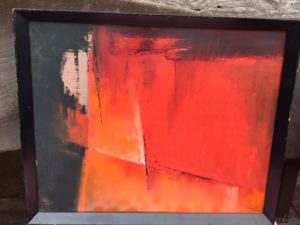 PJ, like so many of us, went through her house looking for stuff to toss. She discovered a pile of paintings her dad left to her in a box in the garage. She sent me an abstract red painting, oil on canvas, framed and glazed. Her dad found this at an estate sale in the 1970’s. “I never liked it. Red’s not my color,” she wrote. “Shall I toss?”
PJ, like so many of us, went through her house looking for stuff to toss. She discovered a pile of paintings her dad left to her in a box in the garage. She sent me an abstract red painting, oil on canvas, framed and glazed. Her dad found this at an estate sale in the 1970’s. “I never liked it. Red’s not my color,” she wrote. “Shall I toss?”
If you think you need to toss something, let me tell you what it might be worth before you do. To find out why I say this, read on.
Why Did Dad Buy a Abstract Red Painting?
She remembered he told her he liked the signature. That’s not exactly a joke. A professional looking signature is a good indication of an accomplished career artist. PJ mentioned her dad liked mid-century modern art before it became hot. This piece is signed Bunnell, 1958, a great year for abstract expressionism. You’ll remember the greats of that era: Jackson Pollock, Barnett Newman, Willem de Kooning, Mark Rothko, Robert Motherwell. No, you don’t have that market level, PJ, but your dad pulled a nice piece out of a 1970’s estate sale.
The artist of your painting is Charles Ragland Bunnell (1897-1968), a painter, a teacher, and a WPA muralist. He loved Colorado, leaving Missouri after WWI to study in Colorado Springs in 1922 at the Broadmore Art Academy (renamed the Colorado Springs Fine Art Center). During his summers of 1929-1941 he returned to Missouri to teach at the Kansas City Art Institute.
The Works Administration Project
During and after the Great Depression, the WPA hired him on as a muralist. He worked with master muralist Frank Mechau on the mural for the Colorado Springs Post Office. A majority of WPA murals used the social realism style, sometimes called the broken color impressionistic style. But rumors say Bunnell possessed the ability to paint in almost any style.
Since his death in the 1960’s his work has appeared many museum shows. One catalog for a 2013 one-man retrospective quoted the artist. “I’ve got to paint a thousand different ways, I don’t paint any one way.” Curator Cori Sherman North created that catalog for a show called “Rocky Mountain Modern” at the Colorado Springs Fine art Center at Colorado College. Send away for the catalogue, PJ, to see what the true beauty of Bunnell’s artwork.
I’m fascinated to imagine a Major American Style like Abstract Expressionism surfacing in the Garden of the Gods in Colorado. Regionalism, no, modernism, yes. Bunnell’s work has exhibited in several one-man shows including those at the Kansas City Art Institute, the Colorado Springs Fine Arts Center, the University of Kentucky, the Santa Fe Museum, the University of Illinois, and the Taos Gallery. His work also became included in exhibitions at the Art Institute of Chicago, the Carnegie Institute, the Colorado State Fair, the Kansas City Art Institute, and in “Artists West of the Mississippi.”
Bunnell learned traditional painting as a student
But through the years he pared down his style to a purified abstraction, rendering pure color, and pure shapes. In 1949 he opened a new studio at the base of Pike’s Peak, close to the Garden of the Gods. Not a bad place to paint, and the landscape influenced his work.
His work from 1949-1968 fits snugly into a style growing in America at that time, a style centered upon NYC, called Abstract Expressionism. Young outsider artists pioneered this style, perhaps in reaction to upheavals in their 1930-1940 world of WWII, post-depression, poverty, and political foment. Wonder what new styles of painting will come out of this COVID crisis.
Abstract Expressionists sought purity of form
What better way to retreat from a world of trouble than to create an art without a message, or subject, or representation. Bunnell also painted in this style, back in Colorado, an unlikely place to do so as Western Landscape Painting became popular in that time and place.
Now comes the fun part where I tell you PJ that the most money paid for a painting by Charles Ragland Bunnell was $24,000. So, your dad did good, and no, don’t put it out on the street.